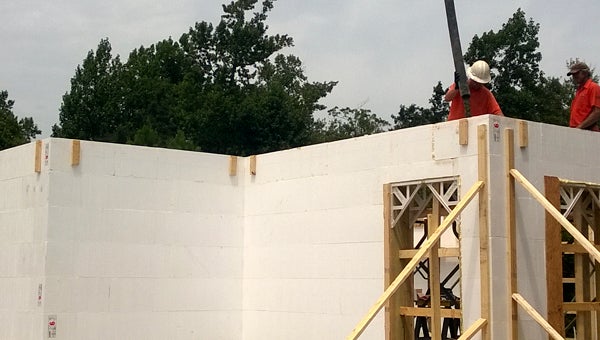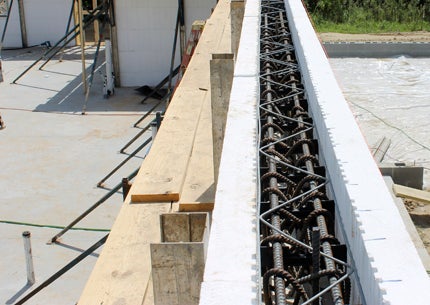HURRICANE HOUSE: Eastern NC home builders have sturdy option
Published 7:42 pm Monday, August 25, 2014

DAN THOMAS | CONTRIBUTED
POUR IT ON: Employees with Dan Thomas Construction build an ICF house in Bath on Friday. A regular concrete truck, with the help of a pumper truck, pumps concrete into the Styrofoam forms that make up the home’s walls.
Since 1999, builder Dan Thomas has been constructing a unique type of home in eastern North Carolina. They’re called ‘hurricane houses,’ or insulated concrete form (ICF) houses.
How they’re created is what sets them apart from the average home construction.
Hollow Styrofoam forms are stacked and connected almost like Lego blocks — windows and doors blocked out. The forms are threaded with rebar, both horizontally and vertically, from the concrete footer all the way to the roof. Once the house is shaped, concrete is pumped into the walls and an exterior façade built—hardy plank, brick, vinyl siding. The end result is a solid, super-insulated home that looks no different than any other home, according to Thomas.
“Visually, from the outside you see absolutely nothing different, from the inside, too,” Thomas said. “If you’re paying attention, the only thing you’ll see is very deep window sills, which most people like. The walls are 12 inches thick. Some folks will do a wood windowsill, granite or marble. It’s a nice place to put plants down. Cats love them, of course.”
In exchange for an average 5 percent cost increase from wood-framed construction, the benefits of an ICF house are worth it, Thomas said.

DAN THOMAS | CONTRIBUTED
INTERNAL STRENGTH: Shone is the web of rebar in the interior of Styrofoam forms ultimately filled with concrete. The combination provides noise insulation and insulation against outside temperatures.
“It’s stronger. It’ll be more comfortable, temperature-wise. It’s safer and will consume less energy, lower energy bills. It’s quieter and it will last quite a bit longer.”
According to one testimonial on Thomas’ website, one homeowner’s electric bill averaged $102.86 a month for the previous 12 months. Another wrote about how a 71 percent increase in square footage over his previous house, translated to only a 12 percent increase in utilities. It all has to do with the insulation properties of the Styrofoam forms and the concrete core: in a perfect environment, a typical home has an insulation value of R-15.
“The ICF wall is about an R-value of 26, but it’s a true R-26. So it might be up to three times (the insulation value) of wood walls,” Thomas said. “The main point is it’s just a much higher insulation value.”
Thomas has been in the construction business for nearly 30 years and the first ICF house he built was for his own family in 1999.
“I think I’ve always been a little more sustainable oriented, even when I started and it didn’t really have a definition,” Thomas said. “It comes from a frugal background — homes that don’t cost so much to live in and last for a long time have always been very appealing to me.”
Since his first, he’s built about 60 hurricane houses in Pitt County, three in Blounts Creek and just last week poured the concrete on a new 2,700-square-foot house in the Bath neighborhood of Treasure Point.
“The clients are very socially minded, or environmentally sensitive,” Thomas said, adding that they chose to build an ICF house in order to leave a smaller carbon footprint — less impact on the natural environment.
Perhaps more relevant to the season, however, is the sturdiness of this type of home, thus the name hurricane house. Thomas said eastern North Carolina severe thunderstorms can’t be heard inside his house and 100- or 110-mph hurricane winds don’t cause a single shudder.
“We’ve had to open doors to tell if the wind was still howling because you really can’t tell,” Thomas said.
In general, they’re more prone not to be destroyed, Thomas said, which many find reassuring in the height of the hurricane season.
For more information about ICF houses or Dan Thomas Builders, visit danthomasbuilders.com and ncicf.com; or call 252-355-3755.





